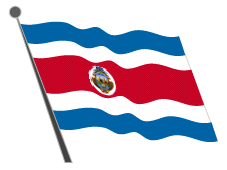 |
 |
 |
General Information
 |
Capital - San Jose (pop. 300,000)
Population - Three million
Language - Spanish
Location - Central American between Nicaragua and Panama (between 8 and 11 degrees north of the equator)
Currency - Colon (Floats, currently $1 US = about 240) in notes of 5,000, 1,000, 500, 100 and 50
Religion - More than 90 percent of Costa Ricans are Roman Catholic.
The last major quake hit on April 22, 1991. Centered on the Caribbean side southeast of San Jose, it measured 7.4 on the Richter scale. The country's highest point is Mt. Chirripo (3,797 meters). The capital, San Jose, and the neighboring major cities of Alajuela and Heredie lies in the middle of the Meseta Central (Central Valley). Almost two-thirds of the nation's population live in this small, fertile valley. The Pacific coastal plain is much narrower than its Caribbean counterpart. Both coasts are lined with white and black sand beaches.
 |
The Indians gave Columbus gold and he returned to Europe with reports of a plentiful supply of the yellow metal. But the adventurers who arrived to cash in found only hostile Indians, swamps and disease for their trouble. Several early attempts to colonize the Atlantic coast failed for the same reasons and for almost half a century Costa Rica was passed over while colonization gathered pace in countries to the north and south. In 1562, the Spanish main's administrative center in Guatemala sent Juan Vasquez de Coronado to Costa Rica as governor and Cartago was established as the capital the following year. With no Indian slaves to work the land, the colonists were forced to work the land themselves, scratching out a meagre subsistence by tilling small plots. The impoverished colony grew slowly and was virtually ignored by the Spanish rulers in Guatemala. By the late 18th century, the settlements that would buela had been founded and exports of wheat and tobacco were making economic conditions somewhat better.
Central America gained independence from Spain on September 15, 1821. The news reached Costa Rica a month after the event. The question of whether Costa Rica should join newly independent Mexico or join a new confederation of Central American states resulted in a bitter quarrel between the leaders of San Jose and their counterparts in Cartago and Heredia. A brief civil war in 1823 was won by San Jose and Costa Rica joined the confederation.
Juan Mora Fernandez was elected the country's first head of state in 1824. His progressive administration expanded public education and encouraged the cultivation of coffee with land grants for growers. This quickly led to the establishment of a new Costa Rican elite, the coffee barons, who quickly put their power to use by overthrowing the first Costa Rican president, Jos‚ Maria Castro. His successor, Juan Rafael Mora, is remembered as the man who mobilized a force of Costa Rican volunteers and defeated William Walker, ending the persistent North American adventurer's ambitions to turn Central America into a slave state and annex it to the United States.
After more than a decade of political turmoil, General Tom s Guardia seized power in 1870. Though he ruled as a military dictator, his 12 years in power were marked by progressive policies like free and compulsory primary education, restraining the excesses of the military and taxing coffee earnings to finance public works. It was Guardia who contracted Minor Keith to build the Atlantic railroad from San Jose to the Caribbean. The post-Guardia years witnessed the fitful transition to full democracy.
The next important era began with the election of Dr. Rafael Angel Calder¢n Guardia in 1940. His enlightened policies included land reform, a guaranteed minimum wage and progressive taxation. But when Calder¢n's United Social Christian Party refused to step down after losing the 1948 election, civil war erupted. The anti-Calder¢n forces were led by Jose Mar¡a (Don Pepe) Figueres Ferrer who had been exiled to Mexico in 1942. Supported by the governments of Guatemala and Cuba, he won the war which lasted 40 days and cost 2,000 lives.
Figueres became head of the Founding Junta of the Second Republic of Costa Rica. He consolidated the reforms introduced by Calder¢n and introduced many of his own: He banned the Communist Party, gave women the vote and granted full citizenship to blacks, abolished the armed forces, established a term limit for presidents and nationalized the banks and insurance companies. He also founded the Partido de Liberacion Nacional. (The PLN won last year's presidential election behind Don Pepe's son, now President Jose Mar¡a Figueres Olsen.
Don Pepe died in 1990 a national hero, his deeds having set the scene for the social and economic progress that would earn Costa Rica the reputation as a peaceful and stable island of democracy in one of the world's most politically unstable, and often war-torn regions. When civil war broke out in neighboring Nicaragua, Costa Rica was drawn reluctantly into the conflict, its northern zone being used as a base first for Sandinista and later for "contra" forces. In 1986, a young lawyer called Oscar Arias Sanchez was elected president on the platform of peace. Arias' tireless efforts to promote peace in the region were rewarded when the five Central American presidents signed his peace plan in Guatamala City in 1987, an achievement that earned him the Nobel Peace Prize.
 |